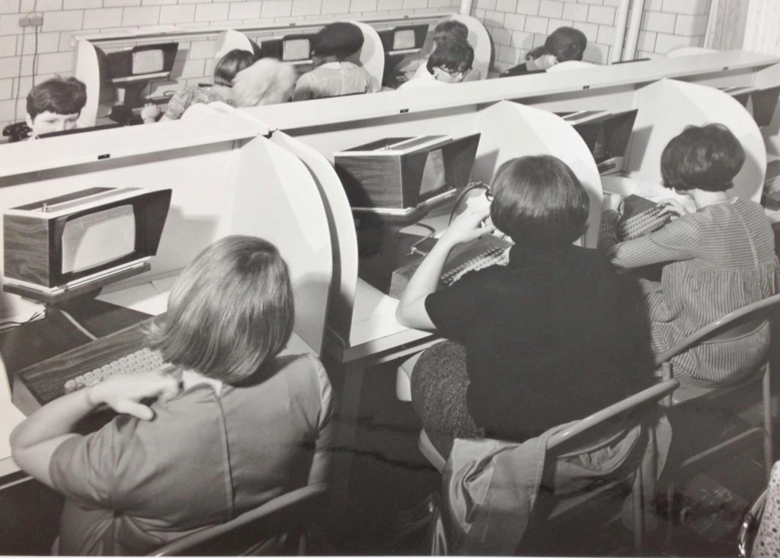“Learning With Machines,” by Ekaterina Babinsteva
October 21, 2020
As a historian of psychology and computing, I am interested in two questions: How did the developments in cybernetics and artificial intelligence (AI) prompt new approaches to understanding the human mind and its creative abilities? And, how did the ideas about minds and computers travel across political, economic and ideological contexts in the twentieth century? I tackle these questions in my book project under the working title Learning with Machines in the Cold War United States and the Soviet Union.
In my book, I argue that despite political, ideological and economic differences in the 1960s and the 1970s, the United States and the Soviet Union articulated a shared vision of the human mind. That is to say, these two countries upheld that the mind was a critical economic resource that could be harnessed by computer technology. On the one hand, this vision emerged as a result of the mid-20th century conceptual and methodological shifts in the psychology of thinking that happened both in the United States and the Soviet Union. Beginning in the 1950s in the US, and a decade later in the Soviet Union, psychologists were drawing on information theory, computer science and artificial intelligence research to develop new quantitative methods of analysis of the human mind.
On the other hand, the conception of the human mind as an economic resource was shaped by the shared specificities of Soviet and American societies. As shown by other historians, in the 1960s both countries embraced the theory of scientific-technical revolution (STR)[1]. Concerned with the social effect of automatic control and digital technologies, the STR postulated that these emerging technologies would restructure societies by reducing the working class and making intellectual labor widespread. Thus, both the U.S. and the Soviet Union became keenly aware of the necessity to prepare larger numbers of their citizens to be capable of performing intellectual work. Reflecting on the similarities between American and Soviet systems during the Cold War, American economist John Galbraith concluded that the economies of the two countries were converging. Galbraith explained that both economies came to be characterized by large corporations requiring similar managerial techniques. Additionally, the growth of American and Soviet industrial systems primarily depended on the intellectual manpower of these two countries.
My book project examines specific American and Soviet computer and algorithmic technologies that were developed to harness learning and problem-solving abilities in the citizens of the two countries. In the U.S. throughout the 1960s and 1970s, the Coordinated Sciences Laboratory (CSL) of the University of Illinois was working on a special teaching computer named with an acronym PLATO (programmed logic for automated teaching operations). The first two versions of PLATO, built in 1960 and 1962 respectively, were shaped by the behavioral approach to psychology. One of the most prominent American behaviorists, B. F. Skinner believed that humans are mere products of the stimuli that they receive from their environment. Based on this view, he considered teaching to be a form of engineering of proper behavior. As shown by other historians, by the mid-1960s, American scientists and society came to view the behavioral conception of the human self as totalitarian [2]. Behaviorism was replaced by cognitive psychology, which shifted the focus from human behavior to the studies of the human mind. It postulated that the mind is independent and creative by nature. These two characteristics—independence and creativity—came to be associated with the core of the democratic self. Thus, the shift from behavioral to cognitive psychology was embedded in political concerns and anxieties of the Cold War U.S.
A significant part of my book examines how the developers of the PLATO computer attempted to adapt to this shift in American psychology. For instance, the PLATO group developed a set of logical operations named Inquiry to create computer lessons that would train students’ independent judgment, critical thinking and problem-solving, the gamut of cognitive features that became visible with the advancement of the cognitive approach. Inquiry allowed PLATO developers to simulate laboratories and doctors’ wards on a computer so that students could discover knowledge on their own, exercising their abilities for independent and creative thinking.
However, as my research demonstrates, PLATO created a rigid and regimented learning environment and produced a notion of creativity embedded in the discourse of Cold War rationality. This discourse was a product of work of a diverse group of American scholars, including political scientists, economists, sociologists, mathematicians and computer scientists, working in the 1940s through 1970s. As they worked in such diverse fields as operations research, rational choice theory, military strategy and artificial intelligence, they came to agree that human rationality could be captured by a set of logical rules and that computers could outdo humans in following algorithmic prescriptions [3]. Working in this intellectual context and drawing on the research that contributed to the Cold War rationality discourse, the PLATO developers created a notion of rule-bound creativity, a kind of creativity that exists only in slightly autonomous conditions and, for the most part, is determined by logical rules.
My book demonstrates that a similar approach to creativity was articulated in the Soviet Union at exactly the same time. Soviet psychologists and engineers considered PLATO to be the paragon of a teaching computer and worked to build a teaching technology on par with PLATO. While Soviet scientists struggled with building the hardware similar to the one created at the University of Illinois, they conducted theoretical work by analyzing the cognitive mechanisms responsible for creativity and problem-solving. For instance, in the late 1960s, Moscow-based psychologist Lev Landa synthesized American and Soviet approaches to AI to develop his formal system of human thinking named the Algo-Heuristic Theory (AHT). While American AI practitioners viewed human thinking as a deductive process, the AHT suggested that deductive logic could not capture creative thinking. Instead, Landa wrote special heuristic prescriptions that would guide humans to the solution of creative tasks. Unlike his American counterparts, he never formalized his prescriptions, as those were meant for humans only. In 1976, Landa fled the Soviet Union, settled in New York City and used the AHT to train American managers.
One may think of various things when they hear the word “creativity:” Picasso’s Cubism art, Shostakovich’s Symphony #7, Einstein’s theory of relativity or Watson and Crick’s DNA model. Those examples of creative thinking challenged existing forms of artistic expression or scientific theories. Yet, as my book project shows, the kind of creativity articulated by Soviet and American developers of teaching technology could not produce any significant shift in science, arts or humanities. Relying uncritically on the knowledge of formal rules, this type of creativity followed existing dogmas, offering solutions to the specific problems of American and Soviet Cold War technocratic regimes.
Nowadays, in our post-Cold War world, the notion of creativity remains central to capitalist economies and high-tech corporations. The latter have made many claims about the uniquely creative nature of the work their programmers and engineers do [4]. Such claims contributed to the devaluation of other forms of cognitive labor that do not fit in the current paradigm of high-tech companies. Thus, I expect that Learning with Machines will prompt a critical assessment of the contemporary technocratic definitions of creativity and other forms of cognitive and physical work that we have deemed to be less valuable and creative.

Ekaterina Babinsteva is the Hixon-Riggs Early Career Fellow in Science and Technology Studies and a visiting professor in the Department of Humanities, Social Sciences, and the Arts. She received her PhD in 2020 from the Department of History and Sociology of Science at the University of Pennsylvania and teaches the Data and Society course at Harvey Mudd College.
Sources
[1] Egle Rindzeviciute, The Power of Systems: How Policy Sciences Opened Up the Cold War World (Cornell University Press, 2016).
[2] Jamie Cohen-Cole, The Open Mind: Cold War Politics and the Sciences of Human Nature, Reprint edition (University Of Chicago Press, 2016).
[3] Paul Erickson et al., How Reason Almost Lost Its Mind: The Strange Career of Cold War Rationality, Reprint edition (University Of Chicago Press, 2015).
[4] Lilly Irani, “The Cultural Work of Microwork,” New Media & Society 17, no. 5 (May 1, 2015): 720–39.